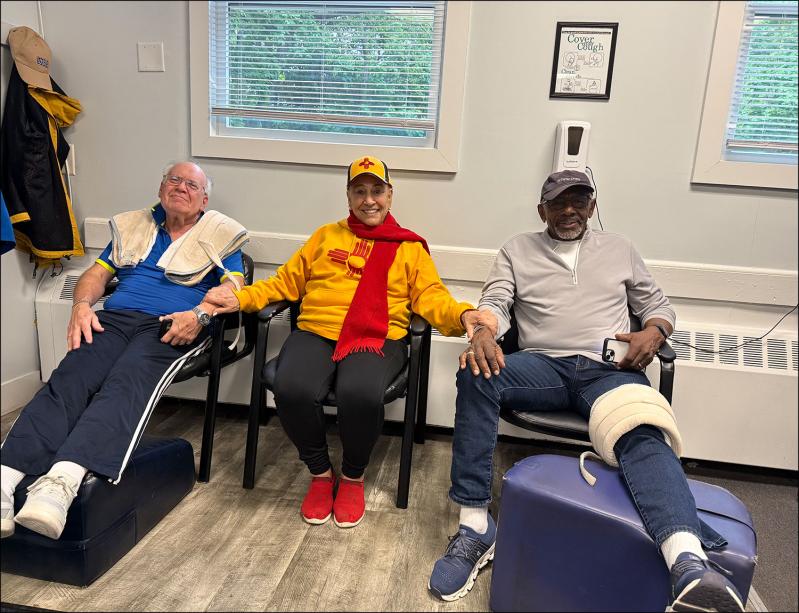An aging athlete — the backstroke, diving, water ballet, softball, tennis (varsity singles in my youth) — I thought that doubles an hour and a half two or three times a week since Covid was enough to keep me strong and in shape. But, to my surprise, “enough” was too much. After years of hard-fought matches, ambushed by aches and injuries, I entered the House of Pain: tennis elbow, right shoulder, right groin, plus the A-word — arthritis. Life as I knew it was endangered.
I tried everything — pain pills, cortisone shots, acupuncture, osteopathy, elevating, icing, wet heat. The worst was serving underhand. All helped less not more or cost too much. Finally, a wise bestie got tired of my bellyaching and said, “You need P.T.: physical therapy.”
News to me, I resisted. I hate gyms. I’m allergic to those menacing rows of steel machines. I called a few friends about P.T. on the Q.T. Everyone recommended the same place — Manual and Sports Physical Therapy in Sag Harbor. I made an appointment.
Manual is at the back of a low, gray building on Bay Street, behind the medical offices of John Oppenheimer, M.D. I was warmly welcomed on a cold day and handed Medicare forms to fill out for the sessions of hands-on message and guided workouts I’d be getting after evaluation.
I took a seat to wait. The lady next to me had a white heat pack around her knee. Across was a gentleman with his walker parked in front of him. Beyond was a whole new world. Twelve hundred powder-blue square feet; a few no-longer-menacing machines; small, medium, and large colored balls on racks; yellow, red, and black (easy to difficult) two-inch-wide elastic rubber loops in piles, and long red and blue rubber bands with handles.
There were four padded massage tables, three with curtains for privacy. The clientele was older.
Then came an odd array of moves and postures: perched on one leg, lying down on a table, knees bent beneath an enormous black ball, or sidestepping with a band around both calves. Rock from the 1970s played in the background, punctuated by beeps and alarms. People focused on their own healing paths, going in different directions. The energy was positive, upbeat, a circus of circuits.
Two young men, Ryan and Kyle, physical therapy aides, darted in and out, the ring masters, directing traffic — seven or eight clients simultaneously, four per hour, 60 to 70 a day, 80 in the summer.
Mary (Mikki) Giffune, doctor of physical therapy, proceeded to push, pull, probe, and prod with practiced fingers, even putting my leg on her shoulder, checking me out. Back pain? Weak core? Balance poor? Flexibility? Motor control?
She wrote down a list of exercises on a flow sheet to target my precise problems and handed me over to the saintly Ryan and Kyle to get down to business.
The drill: I made appointments in advance, each time administered a heat pack for 10 minutes, a licensed therapist’s hands on me for 15, and then back to the aides in charge of my exercise flow charts and my life.
“Walk to the plant and back, three sets of 10” (TSOT), Kyle said cheerfully after slipping a red band around my calves. “Clench your abs when you do the overhead pulley,” piped in Ryan, tweaking my moves. I worked hard: “clamshells” (spreading knees and pushing against the red elastic band), “bridges” (knees up, feet together, trunk up, ease down), squats holding onto a waist-high bar. All TSOT.
Four months of massage and repetitions, icing, icing, icing, week after week, from the end of 2024 through early 2025. It was heaven.
In a huge coincidence, one morning three of the four players in my usual doubles game sat together at Manual, draped in white freezer packs on various limbs and joints, icing for 10 minutes after our respective workouts. We compared notes. “Rehab after second knee op, this one’s better.” “Both shoulders and knees bone on bone.” “Groin tendonitis.” But most important was when we expected to get back on the court. Many getting therapy there socialize quietly — healing separately but bonding together.
I got back on the court in April after a two-month hiatus, not 100-percent painless but in shape mentally and physically. I do my homework, and it makes me feel better.
Also in the spring, I joined Manual’s gym. With 14 machines and two treatment tables, it might be the last bargain in the Hamptons. On my own I can duplicate everything in my routine there, plus weights, treadmill, even an elliptical.
This oasis of healing and empathy has gotten to be a habit with me. For life.
Susan Israelson, a native New Yorker, lives in East Hampton. She is the author of “Water Baby,” a novel, and co-author of “Lovesick: The Marilyn Syndrome.”

